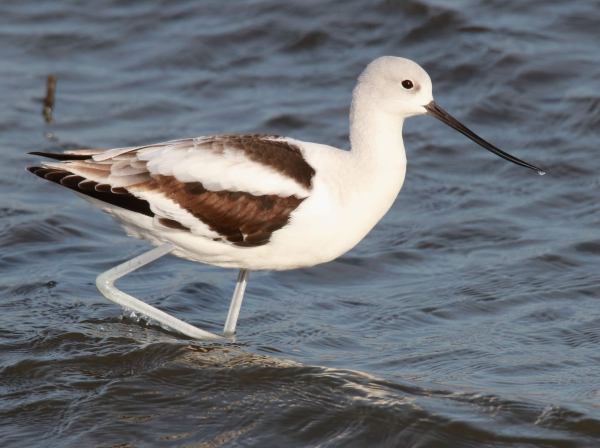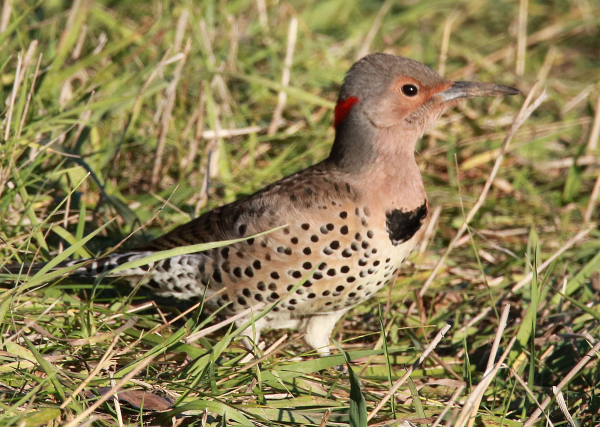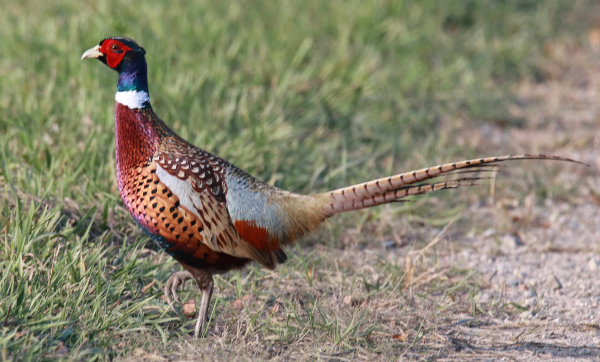
Most shorebirds have migrated southbound, but a few lingering American Avocets, Greater Yellowlegs, and Wilson’s Snipe provide periodic sightings and photographs.

Northern Flickers provided a couple photo opportunities and a new insight when faint moustache markings on each side of the bill indicated at least 2 of the birds were young males.

A glowing Ring-necked Pheasant was on full display in the last sunlight before weekend rains.
|
Monday Morning a north wind backed up the BirdCast forecast of a big migration overnight, as did a loose flock of about 40 American Robins flying above treeline then aloft to the southwest across the open plains. A couple adult Dark-eyed Juncos provided a pretty view as they perched amid the now red sumac leaves, a handsome Yellow-rumped Warbler perched near the feeding station, and a Chipping Sparrow was also active. The migration theme continued to play out during my afternoon birding drive when I viewed another flock robins, juncos, and 2 flocks of Western Meadowlarks along with a group of least 3 Yellow-rumped Warblers.
But the real daylight migration in motion was most evident among the raptors, but not until I reached the edge of the Coteau escarpment and observed fast-moving Red-tailed Hawks using the northeast tailwind to propel them along what appeared to be a 2 mile wide corridor. I counted 7 streaming Red-tails during my short drive along the ridge, plus a Merlin zipping straight-line south near the bottom of the escarpment.
I also had a chance to photograph a female Northern Flicker as it searched for and dug for ants on an area of short green grass and forbs near my friend Herb’s farm. Friday morning I also had a chance to photograph 4 flickers working over ant colonies in similar low green grass on the edge of my friend Kenny’s farm – woodpecker fun. When I reviewed the flicker photos I was surprised to see faint outlines of the telltale black moustache markings on each side of 2 of the flicker’s bills. I thought they were females in the field, even with the magnification of binoculars and my zoom lens, but on my computer screen the faint moustaches suggested they were young males – very interesting, I’ve not seen that before.
Sunny Friday
Highlights of a sunny Friday afternoon birding drive were small flocks of Northern Flickers, Western Meadowlarks, and larger flocks of American Robins – all apparently on migration stops, and there were 3 mini-falcons along the way. The first was a beautifully marked young male American Kestrel that had vivid white underside plumage where most kestrels have a rufous wash on their throat and underside. I wished I could have managed a good photo of the little guy, but it played with me by moving post by post down the road, just a bit out of reach of my zoom lens – then opting to fly south across an expanse of prairie.
The second li’l falcon was a Merlin, although it was even more sketchy and zipped away without even providing a descent look at it. The next mini-falcon was a female Kestrel, but she was already in flight when I saw her, so not a great view either. A gaudy cock Ring-necked Pheasant was my best option on the photo front, and I enjoyed watching him prance through short green grass with his tail held high. He looked more like a spring pheasant than a fall male given this cocky attitude. I covered about 20 extra miles of country real estate that took me within 3 miles of the border of the other Dakota to make the most of the last rays of sunshine before a weekend of rain – a slow soaking rainfall totaling more than 2 inches.
Although there were scattered rainwater ponds across the landscape after Saturday’s soaking rainfall, rejuvenating some ephemeral basins that haven’t held water for 15 months, I hoped for some shorebird action, but most sandpipers have moved on now. A few lingering American Avocets, Greater Yellowlegs, and Wilson’s Snipe are the extent of area sightings, and I enjoy photographing each of these species periodically.
The sun broke through again about an hour before sunset Sunday, punctuated by a migrating flock of about 70 American Crows that flew high past my office. We don’t see many crows in this area, so witnessing a flock in tight formation headed straight south was a welcome sight. It was also an unusual sighting because about 30 Common Grackles were sprinkled among the moving flock of crows – a sight I can’t recall seeing or hearing about before.
Vultures!
Way back last Tuesday afternoon as I left my office with a very strong south wind blowing up the road, I had second thoughts about even taking a birding drive; but that changed quickly when I spied 3 Turkey Vultures floating low overhead. In moments I was enjoying a memorable photo session with 6 Turkey Vultures that were gliding in long circles, allowing me to position at the low end of their gravity-driven glides where the sun provided excellent afternoon lighting. The vultures provided about 20 minutes of fast-paced foto fun, and the surprise photo session was so successful that I used the photographs to illustrate the Bird Photography feature at the end of this issue.
Little has changed during the past couple weeks at my feeding station, where the suet feeder continues to attract male and female Hairy Woodpeckers, male and female Downy Woodpeckers, and at least 2 White-breasted Nuthatches. But any day I expect the norm to change again with the advent of more birds from the north. Native sparrows should arrive any day – Harris’s, White-crowned, White-throated – maybe even a couple early Pine Siskins, and who knows what other new visitors will arrive; but that’s the fun of birding during the change of seasons, right!
Then too, the first Arctic-nesting geese could fly over any moment too, with Snow Geese likely leading the charge that will be followed by tens of thousands more, including 5 species of geese in short order. There are a lot of exciting birds to look forward to, and many exciting hours of birding ahead. What new birds are you looking forward to seeing during the second half of this pivotal month of October?
Article and photos by Paul Konrad
Share your bird sightings and photographs at editorstbw2@gmail.com